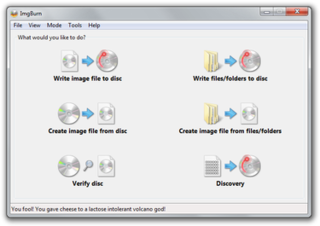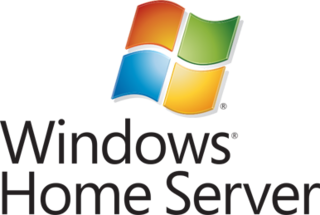
File Explorer, previously known as Windows Explorer, is a file manager application and default desktop environment that is included with releases of the Microsoft Windows operating system from Windows 95 onwards. It provides a graphical user interface for accessing the file systems, as well as user interface elements such as the taskbar and desktop.
Microsoft Photo Story is a free application that allows users to create a visual story from their digital photos. The software uses the Ken Burns Effect on digital photos and allows adding narration, effects, transitions and background music to create a Windows Media Video movie file with pan and zoom effects. Once a photo story has been made, it can be played on a PC using Windows Media Player. Since the .wmv format is used, Windows Media Video Image is incompatible with domestic DVD players, users wishing to create a DVD or CD will need to use third-party tools to convert into DVD compatible format first.
AutoRun and the companion feature AutoPlay are components of the Microsoft Windows operating system that dictate what actions the system takes when a drive is mounted.
The Start menu is a graphical user interface element that has been part of Microsoft Windows since Windows 95, providing a means of opening programs and performing other functions in the Windows shell. The Start menu, and the Taskbar on which it appears, were created and named in 1993 by Daniel Oran, a program manager at Microsoft who had previously collaborated on great ape language research with the behavioral psychologist B.F. Skinner at Harvard.

BartPE is a discontinued tool that customizes Windows XP or Windows Server 2003 into a lightweight environment, similar to Windows Preinstallation Environment, which could be run from a Live CD or Live USB drive. A BartPE system image is created using PE Builder, a freeware program created by Bart Lagerweij.
As the next version of Windows NT after Windows 2000, as well as the successor to Windows Me, Windows XP introduced many new features but it also removed some others.

ImgBurn is an optical disc authoring program that allows the recording of many types of CD, DVD and Blu-ray images to recordable media. Starting with version 2.0.0.0, ImgBurn can also burn files and data directly to CD or DVD. It is written in C++. It supports padding DVD-Video files so the layer break occurs on a proper cell boundary.
Compared with previous versions of Microsoft Windows, features new to Windows Vista are numerous, covering most aspects of the operating system, including additional management features, new aspects of security and safety, new I/O technologies, new networking features, and new technical features. Windows Vista also removed some others.
The Windows shell is the graphical user interface for the Microsoft Windows operating system. Its readily identifiable elements consist of the desktop, the taskbar, the Start menu, the task switcher and the AutoPlay feature. On some versions of Windows, it also includes Flip 3D and the charms. In Windows 10, the Windows Shell Experience Host interface drives visuals like the Start Menu, Action Center, Taskbar, and Task View/Timeline. However, the Windows shell also implements a shell namespace that enables computer programs running on Windows to access the computer's resources via the hierarchy of shell objects. "Desktop" is the top object of the hierarchy; below it there are a number of files and folders stored on the disk, as well as a number of special folders whose contents are either virtual or dynamically created. Recycle Bin, Libraries, Control Panel, This PC and Network are examples of such shell objects.

InfraRecorder is an open-source CD and DVD writing program for Microsoft Windows. First started by Christian Kindahl in the Google Summer of Code 2006, InfraRecorder uses the cdrtools software library to perform the actual burning.

Windows Home Server is a home server operating system from Microsoft. It was announced on 7 January 2007 at the Consumer Electronics Show by Bill Gates, released to manufacturing on 16 July 2007 and officially released on 4 November 2007.

Microsoft PowerToys is a set of freeware system utilities designed for power users developed by Microsoft for use on the Windows operating system. These programs add or change features to maximize productivity or add more customization. PowerToys are available for Windows 95, Windows XP, Windows 10 and Windows 11. The PowerToys for Windows 10 and Windows 11 are free and open-source software licensed under the MIT License and hosted on GitHub.

In computing, the trash, also known by other names such as dustbin, wastebasket, and others, is a graphical user interface desktop metaphor for temporary storage for files set aside by the user for deletion, but not yet permanently erased. The concept and name is part of Mac operating systems, a similar implementation is called the Recycle Bin in Microsoft Windows, and other operating systems use other names.

SyncToy was a freeware tool in Microsoft's PowerToys series that provided an easy-to-use graphical user interface for synchronizing files and folders in Windows versions XP, Vista, 7 and 10. It was written using Microsoft's .NET Framework and used the Microsoft Sync Framework.
The Image Mastering Application Programming Interface, or IMAPI, is a component of Microsoft Windows operating system used for CD and DVD authoring and recording.

Windows Easy Transfer was a specialized file-transfer program developed by Microsoft that allowed users of the Windows operating system to transfer personal files and settings from a computer running an earlier version of Windows to a computer running a newer version.
Some of the new features included in Windows 7 are advancements in touch, speech and handwriting recognition, support for virtual hard disks, support for additional file formats, improved performance on multi-core processors, improved boot performance, and kernel improvements.
Macgo Mac Blu-ray Player is a proprietary Blu-ray Disc media playing software, first released in 2011 by Macgo Inc. It provides playback functionality for Blu-ray Discs, DVDs, and other media formats for Mac and Microsoft Windows. Free trial versions are available for both Mac and PC platforms. It is also a media player for playing Blu-ray Disc/Folder or ISO files on Windows 8.1/8/7/Vista/XP.







